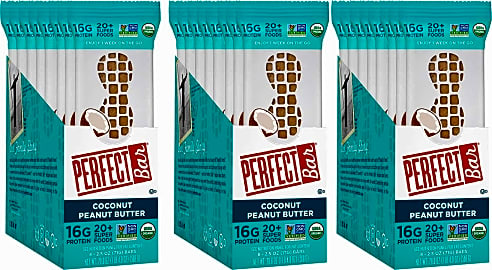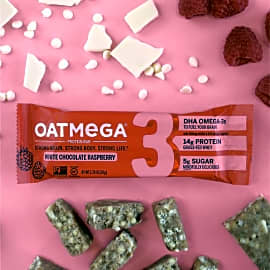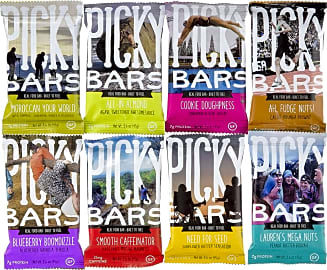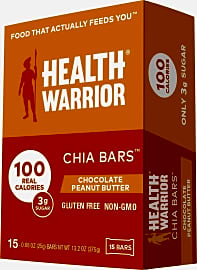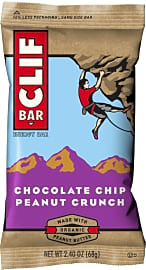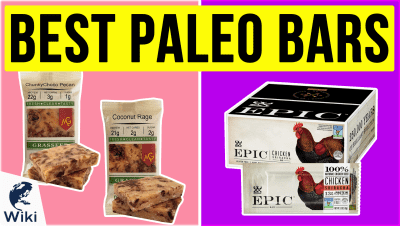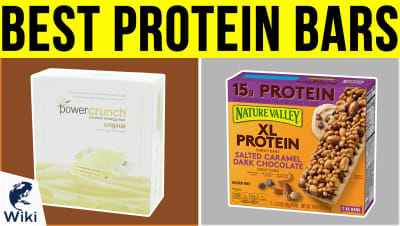The 10 Best Nutrition Bars

This wiki has been updated 45 times since it was first published in July of 2015. Convenient for camping, exercising, or just as a healthy and quick meal substitute, nutrition bars can help you maintain energy and meet your weight-loss goals. They come in a variety of flavors and pack sizes to suit every palate and lifestyle. Our list offers a range of nutritional profiles suitable for those looking to cut sugar, shed pounds, or reduce their carb intake. When users buy our independently chosen editorial recommendations, we may earn commissions to help fund the Wiki.
Editor's Notes
March 10, 2020:
No body is created equal, and while one person may be looking to fuel up for a workout, another may be hoping to slim down through calorie-cutting. Our list of nutrition bars has something for almost every diet and flavor preference.
Those needing a quick serving of protein to keep them energized might like Perfect Bar Original Refrigerated, each flavor of which contains at least 10 grams of protein, and some have as many as 17. Every RXBar Real Food has three egg whites, plus nuts, so it should provide a good amount of fuel. Something else we like about RXBar Real Food are their minimalist ingredients list. Unfortunately, we couldn't say the same for ZonePerfect Crispy & Chewy, which lost its spot.
If it's more complex carbs you're after, Clif Energy, with its rolled oats, and Picky Bars Balanced Energy, which is available in several flavors containing brown rice, are good picks.
Those looking for a tasty way to get more omega's in their diet, in addition to taking fish oil, might like snacking on Health Warrior Chia and Oatmega 3, both of which are full of the heart-healthy nutrient.
If you just want a dessert or snack that may not be as filling as a meal but is healthy and tasty, there are That's It Fruit and Larabar Fruit & Nut.
Special Honors
Fast Bar Nuts And Honey These bars have a simple ingredients list of little more than several varieties of nuts and natural sweeteners like honey and coconut oil. Their flaxseed gives them a fiber boost, and each one has five grams of protein. With 250 calories per bar, they make an ideal snack, and come in a five or 10-pack, so you can stock up. fastbar.com
Lust Protein Bars Lust protein bars contain 18 grams of their namesake nutrient, so they should keep you satisfied for hours. They come in several dessert-inspired flavors like five texture chocolate cake and caramel white chocolate, yet still manage to contain zero grams of sugar. With their added prebiotics, they should be easy to digest. They also have collagen, which may help fight wrinkles and provide arthritis relief. ehplabs.com
A Brief History Of Nutrition Bars
In reality, there is only so much nutrition one can pack into a 44-calorie snack.
Though they're now a staple of many diets and can be found in the kitchens, purses, and desk drawers of people across the globe, the concept of the nutrition bar has only existed for a handful of decades. Moreover, the nutrition bar was in no way conceived as the everyman's meal replacement or midday vehicle for infusing one's system with protein or energy. On the contrary, the first nutrition bars were developed for NASA astronauts to stay satiated while cruising through space.
The original concept was a response to the space food cubes consumed by astronaut Scott Carpenter while orbiting the earth aboard the Aurora 7 spacecraft in 1962. The freeze-dried cubes were the first solid food to be consumed in space, and were treated with an anti-crumbling agent to reduce the likelihood that they would break up and disperse without gravity. Unfortunately, they were crushed before takeoff, rendering the coating ineffective, so bits of freeze-dried food found their way all over the spacecraft during the five-hour mission.
Upon learning of the failed experiment in bringing solid food to space, Pillsbury saw an opportunity to enter an emerging market. They set a team of scientists to the task of creating a snack that was both delicious and suitable for interstellar travel. What they came up with were chewy, individually wrapped Space Food Sticks. They made their galactic debut in 1972 aboard the Skylab 3. In the meantime, capitalizing on popular culture's fascination with outer space at the time, Pillsbury began heavily marketing the sticks to American consumers, offering flavors like "chewy chocolate mint" and "chewy orange" in 44-calorie versions on supermarket shelves nationwide. The packages had the phrases "tasty energy snack" and "balanced nutrition food" emblazoned front and center, and paved the way for the rapid expansion of the nutrition bar market in the decades to come.
The marketing for Space Food Sticks heavily emphasized their portability and nutritional value, with some campaigns incorporating the phrase "miniature balanced meal." In reality, there is only so much nutrition one can pack into a 44-calorie snack. That being said, there were no laws at the time dictating what qualified as nutritious, which the snack industry used to its advantage when it came to marketing products in this newly developed category for decades to come.
In 1986, the first so-called "energy bar" was introduced to the American market. Marketed specifically toward athletes, PowerBars were specially formulated with a high concentration of protein. Their introduction sparked plenty of competition as well as interest from consumers who, while not necessarily athletes, felt they needed an easy way to consume protein on-the-go or wanted to use the bars to replace traditional meals as a dieting technique. To this day, the nutrition bar market remains saturated with options for consumers who identify with one or more of these categories. In an effort to target their products to consumers overwhelmed by the number of choices available to them, many companies have started differentiating their offerings based on certain diets or sources of protein or energy, such as vegan, paleo, and more.
The Difference Between Protein And Energy Bars
Today, most nutrition bars fall into one of two categories, protein and energy bars. In an ideal world, these two designations would have clear differences from one another across the board, but unfortunately that is not the case.
Because protein helps build muscles, these are often favored by athletes.
Generally speaking, protein bars do contain a higher ratio of protein to carbohydrates than do their energy-emphasizing cousins. Because protein helps build muscles, these are often favored by athletes. Energy bars usually also contain protein, because the human body derives energy from three types of compounds in food; fats, proteins, and carbohydrates. A good energy bar will have a balance of all three that helps keep you going without weighing you down, and is usually a good option for those looking for a way to replace a full meal without depriving their bodies of the nutrients it needs over the course of a day.
In reality, however, its impossible to discern anything about a nutrition bar based on the words used as a part of its marketing. Yes, a protein bar is legally required to contain protein, but it might just be a few grams. Nearly all food provides the body with energy, so it's not hard for a company to market its offerings as energy bars, even when they are actually packed full of sugar that's bound to make you crash in a few hours. Calories themselves are a measure of energy, but eating foods that are higher in calories is not necessarily going to help you stay energized. In order to determine what you're actually going to gain from consuming a snack bar, it's necessary to consider your own body's needs while taking a close look at the ingredients and nutrition information printed on the packaging.
Choosing The Right Nutrition Bar For You
The most important factor in choosing a nutrition bar cannot be found in the nutrition facts printed on its label. Rather, it can be found within you. Every individual has different nutritional needs, even if they're participating in the same activities or workouts and eating the same foods as one another.
Once you've considered what nutrients you would most benefit from consuming in a snack bar, it's a good idea to try more than one that fits the bill. Every bar is different, and no two products will leave you feeling exactly the same way after consumption. If you're looking for a meal replacement, for example, make sure you choose a bar that fills you up without weighing you down. If you want a reliable source of protein after exercising, experiment with a few products and see how they impact your recovery and muscle growth over time.
While taste is also an important consideration, try to avoid bars with a high sugar content. Sugar, while a source of calories and therefore energy, is stored in the body as fat, and won't help you feel energized for the long haul. Bars high in sugar will lead you straight towards a dreaded sugar crash.



